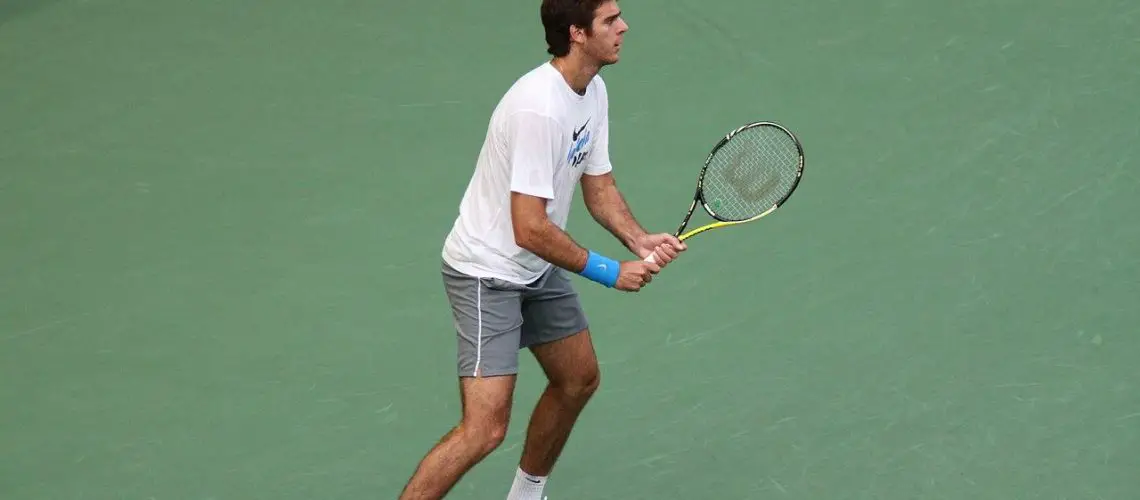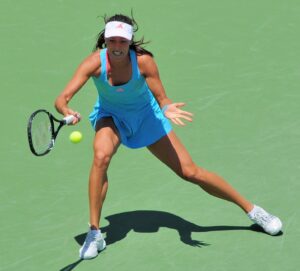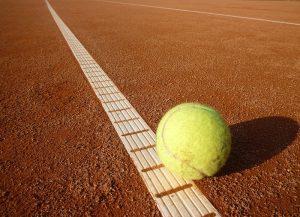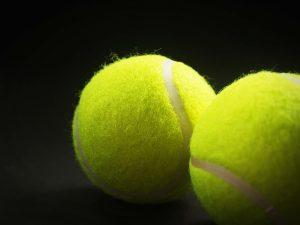We may earn money or products from the companies mentioned in this post.
The Art of the Tennis Slice

Brief Explanation of the Tennis Slice
Tennis slice is a shot that involves hitting the ball with underspin, causing it to spin backwards and slide low over the net It is an essential aspect of modern tennis, as it allows players to control their shots and create a tactical advantage over their opponents
The slice can be used in various ways, such as for defensive purposes or to set up an offensive attack It is also an effective way to neutralize fast-paced shots from your opponent, making it a valuable tool in your arsenal
Common Misconceptions about the Tennis Slice
One common misconception about the tennis slice is that it’s difficult for beginners to learn While it may require some practice and patience, with proper guidance and technique, anyone can master this shot
Another misconception is that the slice is only useful for recreational players and not utilized in professional play However, many top-ranked players rely heavily on the slice as part of their strategy and have won major tournaments using this shot
In Conclusion

The tennis slice is a versatile technique that every player should master With its ability to create different angles and spins on the ball, it can be a game-changer on any court surface By debunking these misconceptions surrounding the tennis slice, you can improve your game by incorporating this valuable skill into your repertoire
Mechanics and Technique for Executing a Tennis Slice

Proper grip for a successful slice
The Eastern backhand grip is the most commonly used grip for executing a tennis slice To hold the racquet using this grip, place your base knuckle on the third bevel of the racquet handle This will allow you to easily pronate your wrist during the swing, generating topspin on your shot However, compared to other grips like the Continental and Semi-Western, this grip may result in less power
Footwork and body positioning
The split step is an essential footwork technique when preparing for a tennis slice Time your split step with your opponent’s contact with the ball to give yourself enough time to move into position and prepare for your shot Proper body positioning is also important in executing a successful slice Always keep your non-dominant shoulder pointing towards the net and pivot on it as you make contact with the ball
Variations in stance are also crucial depending on different situations A closed stance allows you to generate more power but limits mobility while an open stance gives you better court coverage but at the expense of power
Swing technique and follow-through
The preparation phase involves taking your racket back early while simultaneously initiating weight transfer from back foot to front foot Keep your elbow high throughout this phase to prevent dropping of racket head too low or too early which can cause errors or inconsistency in spin generation
The ideal contact zone when hitting a tennis slice is just below waist height allowing you to hit down on the ball creating underspin that makes it difficult for opponents to return effectively
To generate spin, brush up against bottom of ball by having strings facing upward during impact
A proper extension after contact is essential for a successful follow-through This involves extending your arm and racket towards the intended target while staying balanced on your feet Recovery steps should also be taken immediately to get back into position for the next shot
Tactical Applications of Tennis Slices

As a tennis player, mastering different types of shots can give you an edge over your opponent One such shot that can be incredibly useful is the slice The slice is a versatile shot that has many tactical applications on the court Here are some of the types of slices and their uses:
Defensive Slices
If you find yourself on the defensive, a well-executed slice can help turn things around Defensive slices are great for neutralizing your opponent’s attack and regaining control of the point You should use them when you’re out of position or have limited options to hit an offensive shot
To execute a defensive slice, focus on hitting the ball with underspin, which will cause it to bounce lower and slower than usual This gives you more time to recover and get back into position
Approach Shots
If you want to set up net play, using slices as approach shots can be very effective Approach shots are meant to put pressure on your opponent and force them to hit a difficult passing shot A well-placed slice can achieve this goal by staying low and skidding off the court
Variations on approach shots include drop shots, which involve adding more backspin, causing the ball to drop sharply just over the net; and low skidding balls that hug close to the ground, making them difficult for your opponent to handle
Returning Serves with Slices
Serves are one of the most challenging aspects of tennis gameplay However, returning big serves with slices can give you an advantage against big servers by taking away some of their speed and power
Strategies for returning serves with slices include taking them early before they gain too much speed, and aiming them towards the server’s feet to prevent them from getting a good return Additionally, slices can help avoid double faults by keeping your returns in play
Recognizing Opportunities to Employ the Slice During Match Play

Knowing when to use a slice is just as important as knowing how to hit one Here are some factors that can help you recognize opportunities to employ the slice during match play:
Player Matchups
Your opponent’s strengths and weaknesses can determine whether or not you should use a particular shot For example, if your opponent has a strong forehand but weak backhand, using slices on their backhand side can be an effective strategy
Court Surface Considerations
The court surface can also affect which shots you should use during gameplay On grass or clay courts with lower bounces, slices can be more effective than on hard courts with higher bounces
Weather Conditions Affecting Shot Selections
The weather conditions can also have an impact on which shots work best Windy conditions may make it difficult to hit powerful shots, while sunny days may require adjusting your shot selection due to glare off the court
In conclusion, mastering different types of tennis shots is essential for any player looking to improve their game The slice is a versatile shot that has many tactical applications on the court By understanding when and how to use it effectively, you can gain an advantage over your opponents and take control of every point
Tips for Improving your Tennis Slice

Drills and exercises to hone your slice skills
The key to mastering a good tennis slice is practice, practice, practice Self-practice drills can be a great way to improve your technique Two effective drills include drop feed slicing, which involves dropping the ball and practicing slicing it over the net repeatedly, and wall practice where you hit the ball against a wall to improve accuracy
Partner-based drills can also help you sharpen your slice game Crosscourt slice rallies are one such drill that involves hitting back-and-forth with your partner from opposite sides of the court Another useful drill is practicing slice approach and volley where you approach the net after hitting a slice shot and follow up with a volley
Tennis equipment considerations
Your tennis equipment plays an important role in improving your slice technique When selecting a racquet, consider head size, weight, balance, string tension and type as these factors can significantly impact your game
Ball choice is equally important when it comes to improving your tennis slice skills Pressure vs pressureless balls offer different playing experiences that players should experiment with before settling on their preference High-visibility options are also available for players who want better visibility during play
Finding the right coach or online resources
A good coach can help identify areas of improvement in your technique and provide personalized training routines tailored to meet individual needs Look for coaches with experience teaching slices who understand player’s needs
If finding an in-person coach isn’t feasible or desirable, there are many online platforms that offer tutorials on how to improve your tennis game including YouTube channels and subscription-based courses that can be accessed anytime from anywhere
Useful Links

How to Hit a Backhand Slice – How to Play Tennis
How to Hit a Slice Serve in Tennis: Technique and Drills
Don’t let your opponent hit the slice
5 Steps to Hitting a Tennis Backhand Slice
Scoring with tactics: A slice would be good for the game
Tennis skills: all about the backhand slice
The Art of the Slice Backhand
Backhand Slice Tips For Hitting At Different Contact Heights
How to Hit a Slice Serve in Tennis: 4-Step …
What Is A Slice In Tennis?
How To Beat A Tennis Player Who Keeps Slicing the Ball
How to Hit a Slice Backhand
Quick Tip: Hold the “L” for an effective slice backhand
Tennis shots – Wikipedia
Improve your tennis game: Tips for …
Hit a Killer Slice Backhand
How to Return a Slice in Tennis
The physics of Ash Barty’s backhand slice
Backhand slice: THE BASICS ⚡️ #backhandslice #tennistips …






